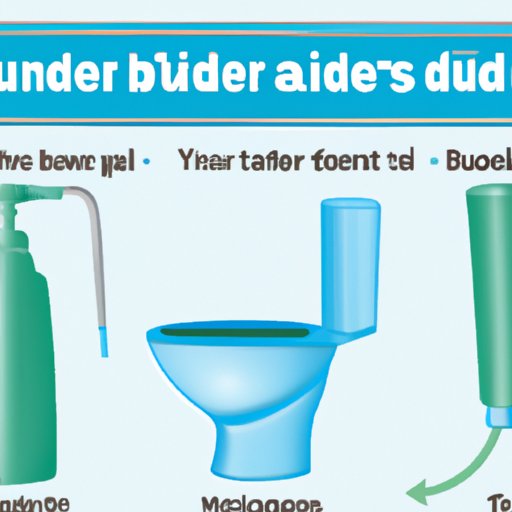Introduction
Bladder infections, also known as urinary tract infections (UTIs), affect millions of people every year. This common infection occurs when bacteria enters the urinary tract and causes inflammation in the bladder. Symptoms include frequent urination, pain or burning during urination, and cloudy or strong-smelling urine. It’s essential to understand the causes of bladder infections, as well as proper prevention and treatment, to avoid further complications and discomfort.
Understanding the Anatomy of the Bladder: A Guide to Bladder Infection
The bladder is a small, muscular sac located in the pelvis that stores urine before it’s expelled from the body. The urine is produced in the kidneys, travels through the ureters, and fills the bladder. However, bacteria can sometimes enter the urinary tract, resulting in a bladder infection. When bacteria enter the bladder, they attach to the bladder walls and multiply, resulting in inflammation. This inflammation causes the classic symptoms of a bladder infection, including pain, discomfort, and frequent urination.

Toiletry Tips: How to Avoid Getting a Bladder Infection
Proper hygiene and toiletry habits are essential in preventing bladder infections. It’s crucial to wipe from front to back after using the bathroom to avoid spreading bacteria from the anus to the urethra. Women should also avoid douching, as it can disrupt the natural balance of bacteria in the vagina and increase the risk of infection. Additionally, urinating frequently and emptying the bladder completely can help prevent bacteria from accumulating in the bladder. Clothing choices, such as wearing cotton underwear over synthetic materials, can also help reduce the risk of infection.
The Science Behind Bladder Infections Explained
Bladder infections occur when bacteria, typically E. coli, enter the urinary tract through the urethra and attach to the bladder’s lining. Some people are more susceptible to bladder infections, including women, who have urethras that are closer to the anus and shorter in length, making it easier for bacteria to enter the bladder. Men can also get bladder infections, usually from an enlarged prostate or complications from a bladder catheter. Other risk factors for bladder infections include sexual activity, pregnancy, weakened immune systems, and use of certain birth control methods.
Different Types of Bacteria That Can Cause Bladder Infections
Several types of bacteria can cause bladder infections, with E. coli being the most common culprit, followed by Klebsiella, Proteus, and Pseudomonas. These bacteria can lead to different types of bladder infections, such as cystitis, urethritis, and pyelonephritis. The severity of the infection can vary depending on the type of bacteria and the location of the infection in the urinary tract. Treatment options depend on the type of bacteria that’s causing the infection.
7 Common Causes of Bladder Infections and How to Prevent Them
Sexual activity is a common cause of bladder infections, given the proximity of the urethra to the anus. Proper hygiene habits before and after sex, such as urinating and wiping correctly, can help reduce the risk of infection. Using spermicides or certain types of birth control can also increase the likelihood of bladder infections. Women who use diaphragms or spermicides should see their doctor for alternative birth control options if they experience frequent bladder infections. Other causes of bladder infections include dehydration, constipation, catheter use, menopause, and weakened immune systems. Drinking plenty of water, avoiding constipation, practicing good hygiene, and staying active can help prevent bladder infections related to these causes.
When to See a Doctor for Bladder Infection Symptoms
It’s crucial to see a doctor for bladder infection symptoms, especially if symptoms persist or worsen. If left untreated, bladder infections can lead to more severe infections, such as kidney infections and sepsis. During a doctor’s visit, urine tests will typically be performed to identify the specific bacteria causing the infection. Antibiotics are commonly prescribed for bladder infections, with pain medication prescribed for discomfort. Women who experience frequent bladder infections may need to seek further medical attention to investigate potential underlying causes.
Natural Remedies for Treating Bladder Infections at Home
While antibiotics are the most effective treatment for bladder infections, some natural remedies can help relieve symptoms. Drinking cranberry juice or taking cranberry supplements can help prevent bacteria from attaching to the bladder walls, making it easier for the body to flush out the infection. Essential oils, such as tea tree oil, can also have antibacterial properties that provide temporary relief. However, it’s important to note that these remedies are not scientifically proven and should not replace medical treatment. Anyone with severe bladder infection symptoms should seek medical attention immediately.
Conclusion
Bladder infections can be uncomfortable and even dangerous if left untreated. Understanding the causes and proper prevention techniques is essential in avoiding bladder infections. Proper hygiene habits, staying hydrated, and avoiding potential risk factors can significantly reduce the risk of bladder infections. If infection symptoms occur, it’s crucial to seek medical attention for proper diagnosis and treatment. By following these guidelines, readers can take steps towards preventing bladder infections and maintaining good urinary tract health.
